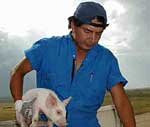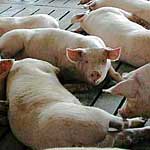By Cara Hetland
Minnesota Public Radio
November 6, 2001
|
| RealAudio |
Opponents of a large hog farm in western South Dakota want to stop the construction. Bell Farms has 48,000 pigs at its facility. Ultimately, the North Dakota-based company plans to have more than 620,000 pigs. The farms are located on trustee land of the Rosebud Sioux Reservation. When tribal government signed a contract with Bell Farms for economic development, tribal members voted in new leaders. Opponents are challenging the validity of the contract and the Eighth U.S. Circuit Court of Appeals is considering the case.
| |
|
|
|
||
When Oleta Minanski takes on a cause, friends and neighbors step aside and let her lead the way. Her cause for the past three years - shutting down what will be the world's largest hog farm.
"There's destruction to the land, air, the water, the people, the animals - everything is going to suffer. These people are here because nobody else wanted them," Minanski says.
The multi-state chain of hog farms breeds and raises pigs for slaughter. One group of barns is already operating in southwestern South Dakota. They call it Grassy Knoll. There are 24 barns with 2,000 pigs in each barn. A second set of barns is under construction seven miles away. Bell Farms has a contract with the Rosebud Sioux Tribe to build 13 sets of barns on reservation trustee land. Oleta Minanski says tribal leaders signed a contract without asking tribal members.
"I just can't believe this happened to us. Can't believe - as a result of all the action that was taken to tell them about our sacred trail, and the fact the people were bypassed. They're just looking the other way," she says.
The tribe signed a contract five years ago with Bell Farms, and Minanski sued to stop the contract. An assistant secretary of the Interior under the Clinton administration ruled the contract void. A South Dakota federal judge says only the secretary of the Interior could make that decision. The judge also ruled even if the tribal government changes, the contract remains valid. The Eighth U.S. Circuit Court of Appeals is considering the case now. Minanski believes construction and operation of the farms should stop until the legal work is done.
"We're going forward with the initial contract, because Bell Farms has lived up to every obligation that the initial contract said we would live up to," says Trent Loos, a spokesman for Bell Farms.
| |
|
|
|
||
Loos is more comfortable talking about the pigs and how they're cared for, than the debate over this project. He believes he's being a good, responsible neighbor. Loos says it's time to show off the operation so people will understand and respect the new direction of agriculture.
"If we don't our job - if we don't do things right that need to be done inside these barns - we're not going to produce a safe, healthy, wholesome food for the American and world consumer," Loos says. "It's only in our best interest to put all these things in front of people."
Grassy Knoll is 150 acres with two dozen barns, an office and a waste lagoon called a digester. It's located in Mellette County, S.D., about 30 miles from the Badlands. This is a huge county with only 1,400 people. More than half the residents are Native American, and the rest are second and third-generation white ranchers.
On this day, 2,000 baby pigs are led into a barn. Farmhands make loud noises with plastic rakes to move them along ramps from a truck to the barn.
The new arrivals will live in this barn for about six months. They'll gain nearly 200 lbs. before they're shipped to a slaughtering plant in Nebraska.
For a hog farm, this is a spic-and-span operation. People don't enter the barns without a shower and company-issued overalls and boots. At each barn door, there's a tub of disinfectant visitors need to step into, to prevent the spread of disease from one barn to another.
| |
|
|
|
||
At every opportunity, Loos points out how well the pigs are cared for. He's most excited about the flushing system. The pigs work their manure through slats in the floor and it ends up in a trench, where 2,000 gallons of water wash it through to a covered digester or lagoon.
It's at the digester where the smell is strongest. It's that smell which upsets neighbors most. Brad Shouldis' family farms downwind from the farm. He says it's difficult to describe the smell, because it's different from season to season.
"Like right now, a person doesn't usually catch any of that pungent smell. I know they've got the liner over the digester, and sometimes the gas will escape from that and that's just flat rank. It'll make you throw up if you sit there too long," Shouldis says. "In springtime you'll get some of that ammonia smell that comes from the urine and solid waste. That's kind of tough to deal with, too."
Bell Farms spokesman Trent Loos says opponents of large farms use the odor issue as a copout.
"If it was as bad as they say it was, no person could physically work in that environment. Yet we don't really think about it," he says.
Loos says the bottom line is that farming has changed. It's a business - a business some people want to use for economic development. On the Rosebud reservation, the unemployment rate is 85 percent. Grassy Knoll employs 18 people, and 14 are Native American. Additional barns will mean about 200 new jobs.
Oleta Minanski says Bell Farms could employ thousands of people and it wouldn't be enough. She says the change to her landscape, the smell and environmental concerns are enough to make it economic destruction.
"We're not against economic development on the Rosebud. We definitely want safe jobs for our people - something they can look forward to every day and not feel bad about going there," Minanski says.
Neighbors want to be able to smell a fresh spring rain, not pigs. Trent Loos believes Bell Farms has a right to be there and expand. The second group of barns is under construction, and site planning is underway for the third set of barns.



